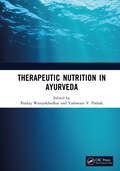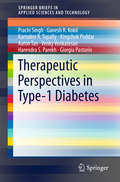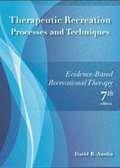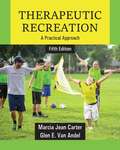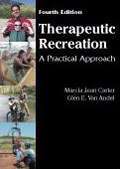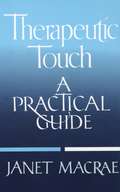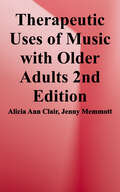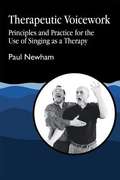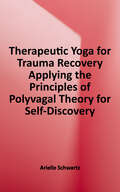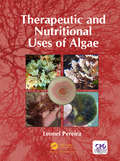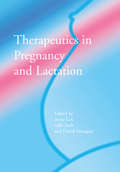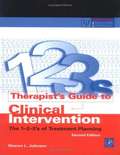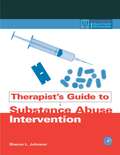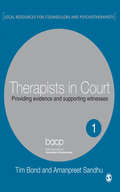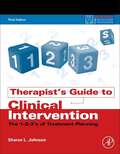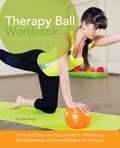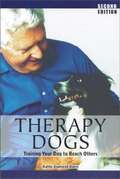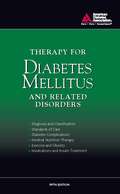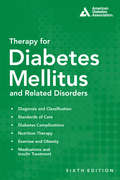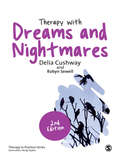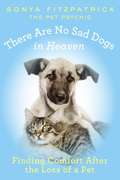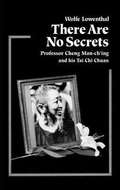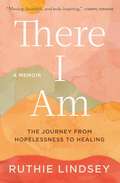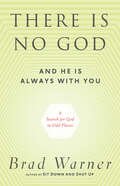- Table View
- List View
Therapeutic Nutrition in Ayurveda
by Yashwant V. Pathak Pankaj WanjarkhedkarNutrition remains the key to the successful treatment of diseases, in addition to the various evolved medical treatments across the world. The treatment outcome improves to a better extent with a degree of nourishment of the patients. Therapeutic Nutrition in Ayurveda (TNA) categorizes diseases system-wise and discusses nutrition with references from Ayurveda classics as well as publications from indexed journals in today’s world. This book emerges as a pilot project to discuss the clinical experiences directly and the concept of nutravigilance by experienced authors of respective specialties like hepatology, neurology, dermatology, ophthalmology, oncology, cardiology, gynecology, and so on. It broadly discusses diet and nutrition based on 12 different groups of diet in Ayurveda. Nutrition has been widely discussed for every disease dynamically in Ayurveda, with details of exclusion and inclusion of foods over a stipulated period or entire duration of treatment. Key Features: Presents system-wise and disease-wise therapeutic nutrition Includes clinical experience of physicians on therapeutic nutrition Contains interdisciplinary discussion on therapeutic nutrition with an integrated approach The integration of traditional and conventional health systems, along with the multidisciplinary approach, is the emerging trend for inclusive health care in the coming decades. This book serves as a handy guide for health care professionals across the continents, providing interdisciplinary correlations on nutrition.
Therapeutic Perspectives in Type-1 Diabetes
by Prachi Singh Ganesh R Kokil Karnaker R Tupally Kingshuk Poddar Aaron Tan Venky Venkatesan Harendra S. Parekh Giorgia PastorinThis book provides critical insights into and appraisals ofrecent breakthroughs in type 1 diabetes modulation, with a particular emphasison the potential impact of current prevention and treatment strategies. It alsodiscusses recent successes and failures in clinical trials. Presenting ancomprehensive overview of the disease, it is especially useful for newcomers inthe field. It also includes illustrations, which make it easy for the reader tograsp the basic concepts involved. Furthermore, the tables include concise andeasy-to-understand information on current clinical trials.
Therapeutic Recreation Processes & Techniques: Evidenced-Based Recreational Therapy
by David R. AustinIn fact, the subtitle, "Evidence-Based Recreational Therapy", has been added to emphasise the importance of evidence-based practice in recreational therapy. Today recreational therapists must possess a broad knowledge base that offers them a foundation for practice. This book explores how to practice recreational therapy yet provides theoretical and empirical evidence to support practice.
Therapeutic Recreation: A Practical Approach
by Glen E. Van Andel Marcia CarterFor over 35 years, Therapeutic Recreation: A Practical Approach has provided an authoritative and engaging introduction to the field of therapeutic recreation. The Fifth Edition of Carter and Van Andel's well-regarded text extends this tradition of excellence, equipping a new generation of students with the theoretical foundations and practical methods they need to become successful practitioners.The authors present the fundamentals of recreational therapy practice from the perspective of a 21st-century health and human service profession: emphasizing evidenced-based practices and documented outcomes, supporting individual and community assets, promoting fiscal responsibility, and utilizing a strengths-based approach that focuses on an individual's capacities when developing a strategy to improve health status, quality of life, and functional abilities.Updates throughout reflect recent scholarship, revised standards and operational definitions, evidence-based literature to support interventions, and global health concerns. The critical component of documentation has been added to discussions of the APIE-D process, while chapters on neurodevelopmental disorders and behavioral and mental health issues incorporate the terminology and organization of the DSM-5. The latest edition also features expanded treatment of social issues and the adult-onset, chronic, and lifelong illnesses and disabilities associated with aging.This full-featured edition retains the student-oriented approach that makes it an ideal text for introductory courses. Illustrations, case studies, key terms, study questions, and practical exercises reinforce key concepts and offer opportunities to apply chapter content, while abundant field-based photographs illuminate the practice of recreational therapy.
Therapeutic Recreation: A Practical Approach (Fourth Edition)
by Marcia Jean Carter Glen E. Van AndelThe fourth edition of Therapeutic Recreation: A Practical Approach reflects the still-evolving nature of this health-care profession and practice in a diverse global world. Social, cultural, demographic, and economic shifts, as well as technological advancements, have created demand for fiscal accountability by informed consumers/clients who expect safe, quality health and human services that are reliable, responsive to their needs, and have proven benefits. Thus our intention is to provide, in a practical, student-oriented fashion, a comprehensive overview of the fundamentals of therapeutic recreation as a health and human service profession and as a career choice. This revised edition is primarily designed for an introductory course in therapeutic recreation at the undergraduate level. Students majoring in health and human service programs or recreation may also find the text useful, particularly if they anticipate careers in health-care settings and agencies that offer inclusionary programs.
Therapeutic Touch
by Janet MacraeA comprehensive instruction guide to the gentle, powerful, non-invasive healing technique being used increasingly both inside and outside the medical profession. Available to anyone searching to help others in pain.From the Trade Paperback edition.
Therapeutic Uses of Music with Older Adults
by Alicia Clair Jenny MemmottIn this comprehensively updated second edition, written by Alicia Ann Clair and Jenny Memmott the extraordinary benefits of music therapy for older adults are detailed. <p><p>Therapeutic Uses of Music with Older Adults not only examines these benefits but also clarifies the reasons that music is beneficial. This important book shows both informal and formal caregivers how to use music to enhance the quality of life of older adults - including people with physical impairments and people with dementia. <p><p>Written by two of the nation's leading music therapists, Therapeutic Uses of Music with Older Adults offers strategies for using music to: provide diversion for inactivity, discomfort, and daily routine; decrease symptoms of depression, anxiety insomnia, and agitation; handle problem behaviors; provide physical and emotional stimulation; help in the rehabilitation of people with cardiac disease, Parkinson's disease, and impairments related to stroke; help in the management of pain; facilitate social integration; communication; and the expression of feelings, including anger and grief; and relieve the stress and tension associated with caring for older adults.
Therapeutic Voicework: Principles and Practice for the Use of Singing as a Therapy
by Paul NewhamNewham explores both the theory and practice behind the use of voice and singing in expressive arts therapy by drawing together ideas from various disciplines.
Therapeutic Yoga for Trauma Recovery: Applying the Principles of Polyvagal Theory for Self-Discovery, Embodied Healing, and Meaningful Change
by Arielle SchwartzTrauma recovery is as much about healing the body as it is the mind. Yet, so often, the focus of healing involvesretelling the story of the pastwithout addressing the physiological imbalances that trauma leaves in its wake. This book bridges this path of healing between the psyche and the body by walking you through the sacred practice of yoga so you can release the burdens of trauma from your body and mind.Grounded within the principles of polyvagal theory, affective neuroscience, and trauma-informed care, this book will help you gain a better understanding of how our brains and bodies respond to stress and trauma and offer a self-led healing journey toward feeling more empowered, grounded, clearheaded, inspired, and at ease. With her innately compassionate and gentle guidance, Dr. Arielle Schwartz introduces you to the power of the yogic philosophy and offers a variety of accessible yoga poses and breathing practices that will allow you to:-Nourish your nervous system -Reconnect with your body -Ground yourself in the present moment -Release unresolved patterns of fight, flight, freeze, or faint -Widen your ability to tolerate emotional discomfort -Develop a felt sense of resilience -Anchor yourself in self-love -Reclaim connection with and trust in your body -Create a personalized yoga practice for your own self-care
Therapeutic and Nutritional Uses of Algae
by Leonel PereiraAlgae have been used since ancient times as food, fodder, fertilizer and as source of medicine. Nowadays seaweeds represent an unlimited source of the raw materials used in pharmaceutical, food industries, medicine and cosmetics. They are nutritionally valuable as fresh or dried vegetables, or as ingredients in a wide variety of prepared foods. In particular, seaweeds contain significant quantities of protein, lipids, minerals and vitamins. There is limited information about the role of algae and algal metabolites in medicine. Only a few taxa have been studied for their use in medicine. Many traditional cultures report curative powers from selected alga, in particular tropical and subtropical marine forms. This is especially true in the maritime areas of Asia, where the sea plays a significant role in daily activities. Nonetheless, at present, only a few genera and species of algae are involved in aspects of medicine and therapy. Beneficial uses of algae or algal products include those that may mimic specific manifestations of human diseases, production of antibiotic compounds, or improvement of human nutrition in obstetrics, dental research, thallassotherapy, and forensic medicine.
Therapeutics in Pregnancy and Lactation
by Anne Lee Sally Inch David FineganThis book will assist doctors, pharmacists, midwives and other health professionals in dealing with the issue of medicine use in pregnant and breastfeeding women. It gives practical guidance on the principles of safe and effective prescribing, summarises the known effects of widely used drugs, and provides up-to-date information in one accessible source. With an impressive list of contributors, Therapeutics in Pregnancy and Lactation offers clear guidelines and comprehensive advice on a diverse range of topics from drug abuse to hypertension and epilepsy.
Therapist's Guide to Clinical Intervention: The 1-2-3's of Treatment Planning (2nd edition)
by Sharon L. JohnsonA must-have reference for clinicians completing insurance forms, participating in managed care, or practicing in treatment settings requiring formalized goals and treatment objectives. This practical, hands-on handbook outlines treatment goals and objectives for each type of psychopathology as defined by the diagnostic and statistical manual by the American Psychiatric Association, identifies skill-building resources, and provides samples of all major professional forms.
Therapist's Guide to Substance Abuse Intervention
by Sharon L. JohnsonAuthor of AP's bestselling "Therapist's Guide to Clinical Intervention" now turns her attention to substance abuse intervention. The book will follow a similar format to her previous book, presenting information in easy to read outline form, with relevant forms, patient questionnaires, checklists, business documents, etc. Part I discusses the social impact of substance abuse and provides a general overview of the physiological and psychological characteristics of abuse, DSM IV definition of abuse, and classifications of the varying types of drugs. Part II is the main section of the book and covers assessment, different stages of abuse/recovery, and treatment choices. Coverage includes the discussion of myriad self-help choices (e.g. AA), group therapy, brief therapy, and more. Discussion will also include making a determination of treatment as inpatient or outpatient, and issues relevant to special populations (teenagers, geriatrics, comorbidity patients, etc.). Part III presents skill building resources. Part IV covers prevention, quality assurance, and also includes a glossary. The book, Outlines treatment goals and objectives, Outlines for assessing special circumstances, offers skill building resources to supplement treatment.
Therapists in Court: Providing Evidence and Supporting Witnesses (Legal Resources Counsellors & Psychotherapists #Vol. 1)
by Tim Bond Amanpreet SandhuTherapists in Court is the first in a series of handbooks providing legal guidance for practitioners from all the talking therapies, including counseling, psychotherapy and psychology. It is written for practitioners who come into contact with the legal system through their work. Providing practical guidance backed up with illuminating examples, the book is an invaluable source of information in situations such as responding to a solicitor's letter, supporting a witness in their preparation to appear in court, and being called as a witness.
Therapist’s Guide to Clinical Intervention: The 1-2-3's of Treatment Planning
by Sharon L. JohnsonTherapist’s Guide to Clinical Intervention, Third Edition, is an essential reference for providing clinical services and associated case formulations requiring formalized goals and objectives. It is ideal for use in assessment, treatment, consultation, completing insurance forms, and/or participating in managed care. This practical, hand-on book, outlines treatment goals and objectives for each type of psychopathology as defined by the diagnostic and statistical manual by the American Psychiatric Association. It additionally provides skill-building resources and samples of all major professional forms likely to be used in clinical treatment. The third edition conveniently maps individualized treatment plans utilizing evidence-based best practices and standards of care. Diagnostic information is presented by associated disorder or theme for easier access. New special assessments and skill-building entries are included. Also new are numerous website/URLs associated with research articles, and consumer resources have been provided to complement clinical information and patient education. Outlines treatment goals and objectives for DSM-IV diagnoses Presents evidence-based best practices of intervention Provides the basis for assessing special circumstances Offers skill building resources to supplement treatment Contains samples for a wide range of business and clinical forms Supplies websites for additional clinical information and patient education
Therapy Ball Workbook: Illustrated Step-by-Step Guide to Stretching, Strengthening, and Rehabilitative Techniques
by Karl KnopfROLL AWAY ACHES & PAINS Therapy balls may be small, but when used properly-they are powerful. With 70 highly effective, self-massage movements, this book shows you how to maximize the healing potential of therapy balls to:*Release tension*Alleviate pain*Rehabilitate injuries*Improve core strength*Increase flexibility Therapy Ball Workbook's clearly explained exercises are paired with step-by-step photos that will help you reduce pain, enhance range of motion, and induce relaxation. It also details the best methods to release painful trigger points and break up soft-tissue adhesions that contribute to chronic pain.
Therapy Dogs: Training Your Dog to Help Others
by Kathy Diamond DavisYou and your dog can become a therapy dog team! Are you looking for a new and meaningful way to work with your dog? Do you want to improve the lives of those who because of illness or disability would benefit from visits with a volunteer canine "therapist"? Then think about becoming a Therapy Dog Team and you will create the kind of magic that enriches lives. Therapy Dogs, Training Your Dog to Reach Others, 2nd Edition gives you all the information you need to select, socialize and train your dog for this work. What better creature than a dog to offer comfort, companionship and even entertainment to people in a wide variety of settings? Don't start an Animal Assisted Activity program at your facility without Therapy Dogs! You will have the latest information on how teams train, prevent problems, deal with liability issues as well as health and safety concerns. Therapy Dogs will help you understand what to look for in a program and in volunteers to assure success. "This revised edition of Therapy Dogs fills a niche in dog training literature by offering a basic lesson plan for therapy dog class, a great resource list and an annotated bibliography." Gently McMillen, Delta Pet Partner and Team Evaluator.
Therapy for Diabetes Mellitus and Related Disorders
by American Diabetes Association Harold E. LebovitzLeading experts on diabetes mellitus share today's most effective diabetic treatments! Our newly revised 5th edition is your comprehensive guide to diabetes symptoms and current standards of care for Type 1, Type 2, and gestational diabetes.New diabetes treatment strategies include medical nutrition therapy with diabetes diet and exercise programs. Learn about our latest research on diabetes medication and technology with insulin-pump therapy, insulin secretagogues, incretin mimetics, and medications for obesity.Explore advances in type 1 diabetes prevention. Family care topic include diabetes in pregnancy, diabetic ketoacidosis, childhood obesity and type 2 diabetes in children. Other topics include glycemic control, diabetes complications and comorbidities, diabetes mellitus therapy in different patient groups and much more. This is an excellent resource for physicians seeking to provide the most current treatment for their patients.
Therapy for Diabetes Mellitus and Related Disorders
by Guillermo E. UmpierrezNearly 100 of the world's leading medical researchers and clinicians share their expertise on the diagnosis, treatment, and care of people with diabetes mellitus. This newly revised sixth edition is a comprehensive guide to type 1, type 2, and gestational diabetes. New diabetes treatment strategies include medical nutrition therapy with diabetes diet and exercise programs. This guide covers the latest research on diabetes medication and technology with insulin-pump therapy, insulin secretagogues, incretin mimetics, and medications for obesity, as well as advances in diabetes prevention. Family care topics include diabetes in pregnancy, diabetic ketoacidosis, childhood obesity, and type 2 diabetes in children. Other topics include glycemic control, diabetes complications and comorbidities, diabetes mellitus therapy in different patient groups, and much more. This is an excellent resource for physicians seeking to provide the most current treatment for their patients. Therapy for Diabetes Mellitus and Related Disorders is the most comprehensive clinical reference work available on the disease.
Therapy with Dreams and Nightmares: Theory, Research & Practice (Therapy in Practice)
by Robyn Sewell Delia Joyce Cushway'Delia Cushway's wealth of experience makes this new edition an essential read for all aspiring counsellors, psychologists and psychotherapists as well as for more experienced practitioners seeking to enhance their practice' - Prof Sue Wheeler, Director of Doctoral Programme, Institute of Lifelong Learning 'I found the book fascinating, illuminating not only my client's material but also my own night-life. The book's strength lies in integrating perspectives from many different psychotherapeutic disciplines, from psychoanalytic to cognitive' - Diana Sanders, Counselling Psychologist and Cognitive Psychotherapist This practical book shows how dreamwork can be a fruitful therapeutic tool for all therapists and practitioners in the helping professions. Emphasising that dreams are a powerful means of accessing an individual's emotions, creativity and wisdom, Delia Cushway has updated the first edition to include: - Skills for working with trauma and survivors of sexual abuse - Cross-cultural, spiritual and religious approaches to dreamwork - Up-to-date research and theory on using Cognitive, Objectivist and Constructivist models and methods - The importance of reflective practice - Scientific functions and meanings of dreams and their role in information processing and memory consolidation. Steeped in practical hints and tips, vivid case examples and methods of interpreting dream language, this highly accessible guide is an invaluable resource for therapists. Delia Cushway is Emeritus Professor of Clinical Psychology at Coventry University and a practising Registered Clinical Psychologist. Robyn Sewell is a Chartered Psychologist and Group Psychotherapist, now fully retired.
Therapy, Shmerapy
by Mindy BlumenfeldHere is the real story of therapy: honest, eye-opening, sharp, and often funny. In this collection of thought-provoking essays you will find out what is therapy; who needs therapy; about the therapeutic relationship; ethics and religion in therapy; and much more. Dare to be entertained and intrigued by a master therapist.
There Are No Sad Dogs in Heaven
by Sonya FitzpatrickOur pets are part of the family. For many they're as close as children; for some they may be our only children. And while most of us can expect that our children will outlive us, sadly, our pets almost never do. Losing a pet can be as difficult as losing any other family member; we grieve, we miss them, and, mostly, we want closure, to know that our furry, feathered, or scaled friends are okay, wherever they are. For years, animal communicator Sonya Fitzpatrick has helped pet owners cope with the loss of their beloved companions. Many of them ask the same questions: Is my pet happy? Why did this happen? Is it okay to get another pet? Using her personal experiences as well as the stories of the families she's worked with, Sonya sheds some light on the questions that every grieving pet owner has, and assures the reader that there are, in fact, no sad dogs (or cats or birds or turtles or horses or cows) in heaven.
There Are No Secrets: Professor Cheng Man-ch'ing and his Tai Chi Chuan
by Wolfe LowenthalThis book is a light-hearted recounting of the life of the late Professor Cheng M'an Ching. The author describes the time he spent at Professor Cheng's New York Tai Chi studio, and some of the lessons learned.
There I Am: The Journey from Hopelessness to Healing—A Memoir
by Ruthie Lindsey&“Ruthie is a gifted storyteller with the unique ability to make you feel her emotions as if they're your own. Her book is somehow both bold and tender and utterly, truthfully, authentically her. She doesn't hide from heartbreak or fail to experience the fullness of all the beauty life can hold.&” —Rachel Hollis, #1 New York Times bestselling author of Girl, Wash Your Face and Girl, Stop Apologizing Brain on Fire meets Carry On, Warrior, There I Am is an arresting inspirational memoir about one woman&’s journey from chronic pain and hopelessness to finding joy, redemption, and healing.At seventeen years old, Ruthie Lindsey is hit by an ambulance near her home in rural Louisiana. She&’s given a five percent chance of survival and one percent chance of walking again. One month later after a spinal fusion surgery, Ruthie defies the odds, leaving the hospital on her own two feet. Just a few years later, newly married and living in Nashville, Ruthie begins to experience debilitating pain. Her case confounds doctors and after numerous rounds of testing, imaging, and treatment, they prescribe narcotic painkillers—lots of them. Ruthie has become bedridden, dependent on painkillers, and hopeless, when an X-ray reveals that the wire used to fuse her spine is piercing her brain stem. Without another staggeringly expensive experimental surgery, she could well become paralyzed, but in many ways, she already is. Ruthie goes into the hospital in chronic pain, dependent on prescription painkillers, and leaves that way. She can still walk, but has no idea where she&’s going. As her life unravels, Ruthie returns home to Louisiana and sets out on a journey to learn joy again. She trades fentanyl for sunsets and morphine for wildflowers, weaning herself off of the drugs and beginning the process of healing—of coming home to her body. Raw and redemptive, There I Am is not just about the magic of optimism, but the work of it. Ruthie&’s extraordinary memoir urges us to unlearn the stories of brokenness that we tell ourselves and embrace the wholeness, joy, and healing that lives inside all of us.
There Is No God and He Is Always with You: A Search for God in Odd Places
by Brad WarnerCan you be an atheist and still believe in God? Can you be a true believer and still doubt? Can Zen give us a way past our constant fighting about God? Brad Warner was initially interested in Buddhism because he wanted to find God, but Buddhism is usually thought of as godless. In the three decades since Warner began studying Zen, he has grappled with paradoxical questions about God and managed to come up with some answers. In this fascinating search for a way beyond the usual arguments between fundamentalists and skeptics, Warner offers a profoundly engaging and idiosyncratic take on the ineffable power of the “ground of all being.”
